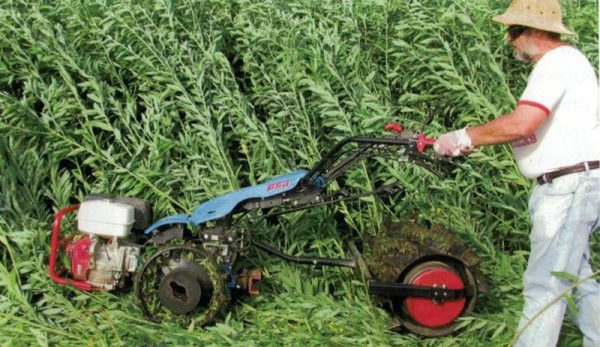
In my last post, we looked at scale—the scale of your growing and scale of available equipment, and how the two intersect. But what scale of equipment do you need for your growing operation?
This question requires a holistic consideration. Let’s start with property size.
Property Size
The amount of acreage you manage is not necessarily a comprehensive way of determining the scale of your equipment needs.
Let’s say you own 300 acres, but 275 of these are forested. You are primarily interested in starting a small market garden on just 2 acres. Well, for any operation under 5 acres, a walking tractor or sub-compact is the way to go.
At 2 acres of vegetable gardening, you could certainly do justice with just a walking tractor and a mix of implements. However, if you wanted to do comprehensive work in the forest, you might consider a 4-wheel tractor.
Additionally, if you had a very long laneway to snow blow, you may want a 4-wheel tractor. At the same time, the 4-wheel tractor would be helpful for moving supplies and compost to your garden plots.
That being said, the fast and efficient operation of a 2-wheel tractor and its maneuverability may still be desirable for the market garden. So perhaps a pairing of equipment would be best.
Another individual, however, might approach the same property and decide that all they want to do in the forest is cut some fire wood with a chain saw, split it with a log splitter (which you can operate with a two-wheel tractor), and haul it home in a pickup truck.
Read more: Read more about growing scale and its relation to varying equipment scales.
Size Is Relative
So again, property size is relative. Although the general rule suggests larger property might require larger equipment, we often find that actual equipment requirements are really relative to what you want to do on your property and how you meet your needs with a compliment of equipment.
On the other hand, if the scale of my entire property was just 3 acres, I would definitely recommend maximizing the space for smaller equipment. That way, I could increase the overall yield of the land by scaling operations to a 2-wheel tractor setup.
Remember, larger tractors need space to move around. And that space often is unproductive laneways.
On the other hand, if you are growing 15 acres of fruit, a small 4-wheel tractor would be much more efficient for many operations, from mowing to harvest. And you can justify the extra space for turning at the end of the rows.
Again, consider your whole property in the equation. If you have 5, 10, 15, 25, 50 or more acres, it is very likely you might have multiple needs for a 4-wheel tractor, if only for its bucket. (I don’t say this lightly. My bucket has paid for itself over many years of farming and homesteading.)
Hands-on
Every grower uses hand tools, no matter the scale. But can you run your entire operation and garden with just hand tools?
Indeed, you can grow a good deal of food (with no more wheels than are on your garden cart) with tools like a shovel, broad fork, garden rake, electric tilther and push seeder! When you compliment these with an electric chain saw, powered weeder and a few other power tools, your equipment set is complete.
For urban and suburban properties between 1/16 and 1 acre, this may be all you need. Large properties could also use just hand tools by increasing the quantity of tools available and the humans available to use them.
With the extra tools and human power, timely activities are performed efficiently and effectively when needed.
Read more: These four hand tools will greatly help out around the farm.
Budget Matters
In addition to questions of property size, you have the question of budget.
Hand tools will cost the least ($), then walking tractors ($$). Subcompact tractors ($$$) follow, then agricultural scale tractors ($$$$$). At certain scales the increase in cost is justified because of the work you can do and the yield (profit) you can achieve.
Say I am growing 12 Permabeds that are 4 feet wide by 25 feet long. I can feasibly build all these by hand with human muscle and hand tools. I can prepare them easily each spring, plant them, weed, water and harvest in a similar fashion using specialized garden tools.
On the other hand, if I had 12 Permabeds at 300 feet long, I may consider a walking tractor and a few implements. This would make the bed building process easier and the spring preparation quicker. Also, I can then get a snow blower so I don’t have to pay my neighbor to blow my driveway!
You Get What You Pay For
Can you manage a 1/3 acre garden with hand tools? Yes! Can you also justify a 2-wheel tractor? Also yes! Because if you want to manage the land for increased bed turnover and multiple crops per year, you effectively crop the ground three times!
This means you are managing more like 1 acre of garden.
A walking tractor will help you quickly mow vegetable debris and re-prepare the bed with a power harrow. In addition, you may have another 1/4 acre in lawn, with some edible landscaping and a driveway.
So now you can blow snow, mow your lawn and even do initial bed prep for your fruit and berry landscaping. The question of expense is ultimately one of utility and equipment versatility.
If you can find a way to use your hand tools, two-wheel tractor or four-wheel tractor in more ways and through more seasons, you will more easily pay for it. And that, my friends, is a good investment.
Be wary of buying equipment you see only seldom use for. Instead, hire these jobs out. We will look more at compliment of equipment in our next article.
Grow on,
Zach




